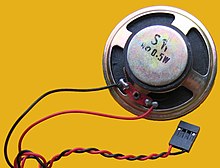PC speaker

Dynamic speaker with 4-pin connector
|
|
| Date invented | 1981 |
|---|---|
| Invented by | IBM |
| Connects to | Motherboard |
| Use | loudspeaker built into most IBM PC compatible computers |
| Common manufacturers | several |
A PC speaker is a loudspeaker built into most IBM PC compatible computers. The first IBM Personal Computer, model 5150, employed a standard 2.25 inch magnetic driven (dynamic) speaker. More recent computers use a piezoelectric speaker instead. The speaker allows software and firmware to provide auditory feedback to a user, such as to report a hardware fault. A PC speaker generates waveforms using the programmable interval timer.
The PC speaker is used during power-on self-test (POST) sequence to indicate errors during the boot process. Since it is active before the graphics card, it can be used to communicate "beep codes" related to problems that prevent the much more complex initialization of the graphics card to take place. For example, the Video BIOS usually cannot activate a graphics card unless working RAM is present in the system, while beeping the speaker is doable with just ROM and the CPU registers. Usually, different error codes will be signaled by specific beeping patterns, such as e.g. "one beep; pause; three beeps; pause; repeat". These patterns are specific to the BIOS manufacturer and are usually documented in the technical manual of the motherboard.
The PC speaker was often used in very innovative ways to create the impression of polyphonic music or sound effects within computer games of its era, such as the LucasArts series of adventure games from the mid-1990s, using swift arpeggios. Several games such as Space Hulk and Pinball Fantasies were noted for their elaborate sound effects; Space Hulk in particular even had full speech.
...
Wikipedia
